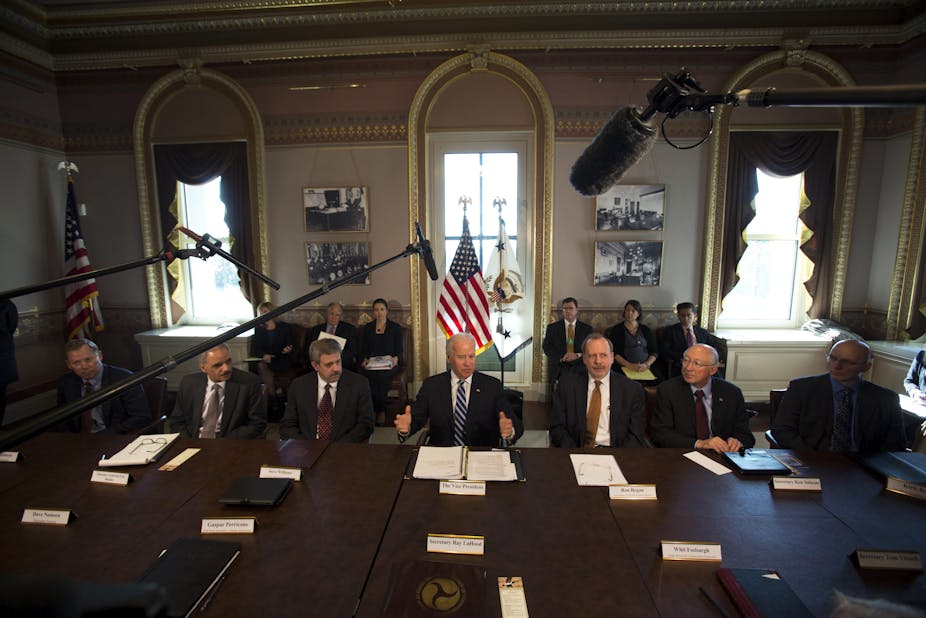The gun control debate in the United States has been reawakened for the new year, with Vice President Joe Biden providing President Barack Obama with 19 recommendations for action on guns. As The Economist noted last year, when it comes to gun control, “this time may - just - prove different”.
But we should not fool ourselves. Introducing measures such as closing the “gun-show loophole”, requiring background checks, tracking the movement and sale of weapons and banning assault weapons and high capacity magazines will not eradicate the potential for mass casualty attacks. Rather, these actions are designed to prevent the frequency and extent of such incidents.
Following the 1996 massacre in Port Arthur, Tasmania, which killed 35 people, strict gun control measures were brought in across Australia. As a result, more than 650,000 automatic and semi-automatic rifles were handed in and destroyed. Research published in the American Law and Economics Review noted the benefits. It found that firearm homicides dropped 59% in Australia between 1995 and 2006.
In 2011, Harvard University researchers revealed that in the 18 years prior to 1996 there were 13 mass casualty attacks involving guns in Australia (mass casualty attacks being defined as those with four or more fatalities). Since the introduction of gun control laws there have been none.

Historical and cultural differences between Australians and Americans in their attitudes towards gun ownership mean that the scale of the issue in the United States is far greater than that faced by Australia. There are as many as 300 million guns throughout the United States and organisations such as the National Rifle Association wield enormous power and influence. There is also an ingrained scepticism throughout American society towards any move perceived as the federal government restricting the rights of the individual. These factors help explain to outside observers why reinstating the bans on the sale of assault weapons has not managed to gain widespread support, even after a series of tragic mass shootings.
The gun control debate is not just important in the context of school shootings but is also relevant to all forms of mass casualty attacks, including those that are religiously or ideologically inspired. In June 2011, al Qaeda’s media production arm released a video urging sympathisers to attack targets in the United States with firearms. It noted that “America is absolutely awash with easily obtainable firearms” and that the faithful should take advantage of the country’s gun stores and gun shows. Inspire magazine has also repeatedly urged such undertakings.
Since 9/11, there have been around 50 foiled attempts to carry out a mass casualty attack on American soil in the name of jihadist ideology. An additional four attempts have been successful and resulted in fatalities - at Fort Hood, Little Rock, the Seattle Jewish Federation and Los Angeles Airport. Each successful attack has involved firearms.
In August last year, six people were killed when a gunman with ties to the white supremacy movement opened fire at a Sikh temple in Wisconsin. The 69 Norwegians killed by Anders Breivik in July 2011 remind us of the potential damage assault weapons and high capacity magazines can cause in a civilian environment (eight were also killed in an associated bombing).
There has also been a significant increase in attempted jihadist plots in Western countries over the past five years. However, many of the perpetrators often have little or no training or expertise and these plots have tended to be less sophisticated than previous efforts more directly connected to international terrorist organisations. Importantly, there is a strong relationship between recent plots and a desire to use conventional weaponry (rather than explosives which require the acquisition of a number of materials and are difficult to assemble). In the same way that restricting the sale of certain chemicals may have gone some way to preventing a bombing inspired by jihadist ideology in America post 9/11, restricting access to assault rifles and high capacity magazines may also help prevent a large scale attack.

The introduction of restrictions on the sale of firearms in Australia has helped prevent such a mass casualty attack. In 2005 and 2009, cells were intercepted in Victoria which planned to conduct mass casualty attacks in the name of jihadist ideology. Both unsuccessfully attempted to procure guns from the black market.
The 2005 cell used money raised through criminal activity in an attempt to purchase firearms for the group. Three men were also convicted of planning a suicide mission on Holsworthy Army Barracks in 2009 using guns that carried “up to 60 bullets”. These men were recorded commenting that with this type of weaponry, “20 minutes would be enough” to inflict mass casualties.
Fortunately, both groups had difficulty acquiring such weapons and authorities were able to intercept both cells before an attack could take place. These examples highlight the fact that for those wanting to inflict mass casualties, automatic weapons with high magazine capacities are the best weapon choice. Though the extent of the preparation and skill of a shooter is important, it is the equipment used that may ultimately determine the extent of the damage, particularly if a shooter lacks expertise.
Protecting citizens from mass casualty attacks must be the first security priority of any nation. Whether an attacker is motivated by distorted religious teaching, mental illness or revenge, governments must find ways to restrict the extent of the damage such individuals can potentially cause.
By introducing significant gun control measures President Obama has an opportunity to leave a legacy of helping to secure the safety of the American people.

